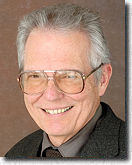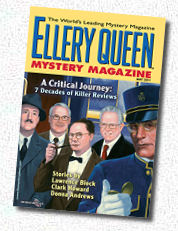


![]()
|
Jon L. Breen  Dertig jaar was Jon L. Breen
verantwoordelijk voor de rubriek "The Jury Box" in
Ellery Queen's Mystery Magazine
terwijl hij ook nog The Armchair
Detective van besprekingen voorzag. Jon nam
de rol van EQMM
detective criticus over van John Dickson Carr in
1977, en ondanks het feit dat hij in 2011
van zijn maandelijkse rubriek afstand nam
toch zal hij nog tweemaal per jaar met veel
inzicht besprekingen van nieuwe detective
verhalen in EQMM bezorgen. Als detective
schrijver, heeft Jon tweemaal de Mystery
Writers of America’s Edgar Allan Poe Award
ontvangen, eens in 1982 en eens in 1985. Hij
heeft verschillende verhalen en meer dan 100
kortverhalen op zijn actief
(2),
en droeg regelmatig bij aan Mystery Scene en niet zo
regelmatig een (niet-politieke) bijdrage aan
The Weekly
Standard. Dertig jaar was Jon L. Breen
verantwoordelijk voor de rubriek "The Jury Box" in
Ellery Queen's Mystery Magazine
terwijl hij ook nog The Armchair
Detective van besprekingen voorzag. Jon nam
de rol van EQMM
detective criticus over van John Dickson Carr in
1977, en ondanks het feit dat hij in 2011
van zijn maandelijkse rubriek afstand nam
toch zal hij nog tweemaal per jaar met veel
inzicht besprekingen van nieuwe detective
verhalen in EQMM bezorgen. Als detective
schrijver, heeft Jon tweemaal de Mystery
Writers of America’s Edgar Allan Poe Award
ontvangen, eens in 1982 en eens in 1985. Hij
heeft verschillende verhalen en meer dan 100
kortverhalen op zijn actief
(2),
en droeg regelmatig bij aan Mystery Scene en niet zo
regelmatig een (niet-politieke) bijdrage aan
The Weekly
Standard.
EQMM beschreef Jon als "...een schrijver van boeken en kortverhalen, bibliothecaris, anthologist, en leraar Engels" die de rubriek The Jury Box voor EQMM schreef "...met integriteit, inzicht en stijl..." Jon Breen is sedert lang de werken van Ellery Queen toegewijd. In zijn artikel “Ellery Queen,” welke deel uitmaakt van The Tragedy of Errors, merkte Jon op dat “los van het schrijven van sommige van de meest ingenieuze detectives van hun tijd,” Dannay en Lee ook verantwoordelijk waren voor “het creëren van één van de weinige detective helden uit het Gouden Tijdperk die met zijn tijd meegroeide en evolueerde van boek tot boek.” Welnu dit kan ook van Jon zijn werk gezegd worden. Zoals Mike Grost (4) bemerkte sommige van Jon's vroege werken waren geschreven als  satirist
en pastiche schrijver, in hoofdzaak korte "spoofs" van
andere schrijvers uit het Gouden Tijdperk.
Specifiek, was Jon bekend omwille van
het schrijven van verschillende Queen pastiches of
parodieën, en schreef ook menig artikel over
de kunst van het schrijven van deze
pastiches. Jon bezorgde ons het
volgende artikel, welke de groei van de
personages beschrijft en de chronologische
problemen die dit teweeg bracht om Ellery
blijvend in eigentijdse settings te
portretteren. Als kers op de taart vind je
hier ook een herpublicatie van één van Jon’s
Ellery Queen parodieën, die
zich afspeelt in 1975,
gelijktijdig met de première of the NBC
TV-serie
Ellery Queen, een
schoolvoorbeeld om het thema van zijn essay
te illustreren!! satirist
en pastiche schrijver, in hoofdzaak korte "spoofs" van
andere schrijvers uit het Gouden Tijdperk.
Specifiek, was Jon bekend omwille van
het schrijven van verschillende Queen pastiches of
parodieën, en schreef ook menig artikel over
de kunst van het schrijven van deze
pastiches. Jon bezorgde ons het
volgende artikel, welke de groei van de
personages beschrijft en de chronologische
problemen die dit teweeg bracht om Ellery
blijvend in eigentijdse settings te
portretteren. Als kers op de taart vind je
hier ook een herpublicatie van één van Jon’s
Ellery Queen parodieën, die
zich afspeelt in 1975,
gelijktijdig met de première of the NBC
TV-serie
Ellery Queen, een
schoolvoorbeeld om het thema van zijn essay
te illustreren!!Boven rechts: De lijn van critici bij EQMM is indrukwekkend: Howard Haycraft, Anthony Boucher, John Dickson Carr, Al Hubin, Jon L. Breen en nu Steven Steinbock.
Kurt Sercu |


|
THE EXPANDABLE CALENDAR OF When Edward D. Hoch and I were asked to write new Ellery Queen cases for the September/October 1999 issue of Ellery Queen’s Mystery Magazine, which commemorated the 70th anniversary of The Roman Hat Mystery, we first had to address a thorny question: in what period should the stories be placed? The 1920s where the saga began? The 1960s where the official saga ended? The peak decades in between? We each decided on the present. In Ed’s “The Circle of Ink,” Ellery lectures to casually-dressed college students with laptop computers, while my “The Gilbert and Sullivan Clue” includes a reference to the coming and much-feared advent of Y2K.
Our decision was an
appropriate one. Like Agatha Christie’s Hercule Poirot, Rex
Stout’s Nero Wolfe, and quite a few other detectives long on
the scene, Ellery Queen pretty much ignored
the problem of aging. Just as The Roman Hat Mystery
(1929)
was set during the theatrical season of 192-, the principal
events of the final Queen novel, A Fine and Private
Place (1971),
were clearly dated 1967. Ellery the sleuth always lived in
the present, and his cases were often packed with current
topical references. True, The Finishing Stroke
(1958)
flashed
back to the late 1920s and gave Ellery the sleuth the same
birth year, 1905, as his creators Frederic Dannay and
Manfred B. Lee. But the resurgent Ellery who resurfaced in
The Player on the Other Side
(1963)
did not
seem to have aged beyond 53 or even that far, and his
elderly father’s retirement in Inspector Queen’s Own
Case (1956)
was ignored, permitting the pair to
continue through the 1960s pretty much as usual. |
|
|
The Adventure of the Disoriented Detective © 1976 by Jon L. Breen “Healy,” said Inspector Richard Cune, “I’m worried about E. Larry. You and I never seem to change, but E. Larry is not the man he was.” A worried frown crossed Sergeant Healy’s beefy face. “What’s the matter with the Maestro, Chief? He seemed fine the last time I saw him, during that Swedish Boot business.” “Yeah, but just lately he’s been acting really funny. Forgetful for one thing—never on time for dinner, misses appointments. Also, he’s always falling over things—I told him he should get his eyes examined, it might be astigmatism, but he says, no, dad, I’m all right, and just goes stumbling on his way.” “Doesn’t sound so serious, Inspector. He must be working on a plot for his next book that’s giving him a hard time. Once he gets it licked, he’ll be his old self.” “I’m not so sure, Healy. If that were the worst of it, I wouldn’t be so worried, but there’s something else.” “What?” “He doesn’t know what year it is. He keeps talking about how President Truman should do this or that. He can’t understand why he can’t get Jack Benny on the radio. He dresses in 1948 clothes—I don’t know where he gets them. I tell him, ‘E. Larry, it’s 1976, not 1948,’ but he just looks right through me, doesn’t listen. He hums tunes from Finian’s Rainbow, and when I mention Elton John or Mick Jagger, he doesn’t know what I’m talking about.” “Gee, Inspector, I like Forties’ show tunes, too, and I never hear of Elton Who-did-you-say or Mack Jigger either.” “Okay, okay, so that’s not really our generation. But he also never heard of Kojak or Columbo or Archie Bunker or Johnny Carson, and he thinks Ronald Reagan’s a movie actor.” Healy whistled. “Gee, Inspector, that sounds serious.” The birdlike Inspector Cune cocked his head at the fly-stained headquarters clock. “I’d do anything to bring him out of this, and this new case seems to be right up his alley. Or course, he’s an hour late as usual. At that moment, E. Larry Cune stumbled into his father’s office, banging his head on the door sill in the process. “Gosh, dad, I don’t remember that door being so low.” “It’s the same as the day this place was built, son,” said his father wearily. “Perhaps you’ve grown.” “You’re getting to be a regular Kareem Abdul-Jabbar, Maestro,” said Healy with forced heartiness. E. Larry gave the sergeant a puzzled look. “Who? What?” “A giant, like Wilt the Stilt.” “Wilt the Stilt?” E. Larry echoed, totally confused. “Like George Mikan,” E. Larry’s father explained with a worried frown. “Gee, dad, I’m not that tall,” E. Larry remonstrated. “Enough small talk. I have a tough case here, son, and I need your help.” “Sure, dad, just so it doesn’t take too long. I have a book on the stove that will make the world forget Philo Vance.” “Look, son, here’s the situation. A man named Charles Talbot was found shot to death last night in his apartment, a rundown place on the east side. Talbot was down on his luck, but he’d enjoyed great success as one of the slickest bunco artists around. In fact, a few years ago, he’d founded a firm of high-rise confidence men, real big-time operators. They were all gray and distinguished-looking types who seemed able to gain the trust of the smartest business minds in New York and suck them into fantastic agreements that would make buying the Brooklyn Bridge from a wino look like a shrewd deal. We managed to rout his gang a few years ago, when they went a step too far, but the mastermind Talbot escaped, and apparently so did one other.” E. Larry’s features looked blank and bemused. Sergeant Healy inwardly doubted that this slack-jawed sadsack could ever have displayed the incisive, razor-sharp intellect that had been pulling his father’s chestnuts out of the fire for so many years. “I don’t remember the case, dad. You say his name was Talbot—” “Yes, but he was better-known as Ephraim Dean Arnold. Surely you remember that—half the executives on Manhattan blush at the mention of the name.” “Gee, I don’t, dad. What year was that?” Healy started to say, “Nineteen seventy—” “Oh, I don’t know, four or five years ago,” Inspector Cune interrupted quickly. Now that E. Larry was showing some slight interest, he felt that insisting too hard that it was 1976 might case a relapse. It would take great care to ease him back to reality. “Talbot,” the Inspector continued, “had recently been using the name Gene Arthur Effington and trying to pull some of his same old tricks, with less success. In the pocket of the shirt he was wearing when he did, we found five empty envelopes, each addressed to a prominent executive, people he apparently was going to try one of his bunco schemes on. But there was also an unfinished draft of a letter that we think was intended to go to one of them. We just don’t know which. The letter read: Dear Joe, I was certainly disappointed at your failure to acknowledge my previous missive. I hope you know that my congratulations to you as the only one of our old bunch to stay on the top, when the rest of us were dropping like flies, were most sincerely meant. And I wouldn’t want to think that you took my statement about what a word from me in certain prominent ears might do to your present good fortune as anything like a threat. Would I, if you’ll excuse a lapse into the vernacular, rat on a pal? It happens, though, that I am somewhat financially embarrassed, and surely a true friend would be happy to help out his old associate in a time of “It broke off there. We interpret it to mean that one of the old bunco ring is still out among ‘em, so to speak, and that Talbot was threatening to expose him. And probably the recipient of that first letter sought Talbot out and killed him before the second even got finished and mailed.” “And it seems likely this second letter was going to go to one of those five executives the envelopes were addressed to.” “Right, son!” “And therefore that one of the five addressees is the murderer.” “That’s just what we think, Maestro,” Healy put in. “But which one?” “That’s the problem all right, son,” said Inspector Cune. “And the name Joe is probably no help, since the executive probably uses an assumed name, probably the same one he used as a member of Talbot’s bunco firm.” “And there are no Joes on the list anyway. The names are Wilton Frederick Comstock, Albert Gregory Post, Arthur Emsworth Endicott, Milborne Cosmington Fosdick, and Randolph Terwilliger Hooper.” “A formidable group of names,” E. Larry mused. “Both in terms of influence and total syllables.” Inspector Cune smiled inwardly. E. Larry was getting involved. Perhaps his grand and glorious brain was about to shake its fog of disorientation. “Dad, what were the names of the other members of Talbot’s bunco firm, the ones you caught up with?” “You want their real names or their aliases?” “Their aliases. I don’t care about their real names.” “Well, there was one who called himself Eldon Jason, posed as a Western self-made millionaire, a rough-hewn character with a shrewd brain for business. He had a nickname. What was it, Healy?” “Beans,” said Healy. “Beans Jason, a real shifty character.” “Then there was Teel Armstrong, Eulalie Esther Jeeter, the only female member of the gang, Ames Eldon, Jason Ephraim Kane—” “Another Ephraim and Eldon,” E. Larry mused. “Not common names. I wonder why they should have been repeated. Did anyone reveal how they came up with these aliases, dad? Did each member of the gang come up with his own false name?” “No, as a matter of fact, Talbot chose them all himself. Insisted on it. They say he had a genius for coming up with trustworthy names.” “And usually three names, but not always. Could it be there was some subtle joke hidden in the names he chose? Let’s review the aliases we know originated with Talbot, dad, starting with the ones he used himself. Ephraim Dean Arnold. Gene Arthur Effington. Eldon “Beans” Jason, Teel Armstrong, Eulalie Esther Jeeter, Ames Eldon, Jason Ephraim Kane—I’ve got it!” To his father’s dismay E. Larry turned away and started talking to a blank wall. “You see it, don’t you? One of the names on the list of executives Arnold was going to write to fits right in with the list of his gang members’ aliases. So perfectly there should be no doubt which of names on the list belongs to a former gang member that Talbot was planning to blackmail. You can figure it out. You know everything I do.” “E. Larry,” his father roared with exasperation, “who in hell are you talking to?” E. Larry whirled around. “Nobody, dad, nobody. But I have your case solved. What do all those names have in common? Come on, Healy, you must see it.” “’Fraid not, Maestro. They’re just a bunch of names.” “Don’t just look at the names on the paper. Say them out loud. Each name includes letters, initials. I don’t mean the first letter of each word. I mean a letter that appears in the word as spoken. Eulalie Esther Jeeter. U.S.G. See what I mean? Or Teel Armstrong. T.R. Or Gene Arthur Effington. G.R.F. And those initials also have something in common.” “What’s that, son,” the Inspector asked, looking at his son blankly. “Take the easiest one of all. Ephraim Dean Arnold. F.D.R.” “I get it!” Healy cried. “F.D.R.—Franklin Delano Roosevelt. And Jason Ephraim Kane is J.F.K.—John F. Kennedy. They all have the initials of United States Presidents in their names.” “Right,” said the Inspector. “Eldon ‘Beans’ Jason would be L.B.J.—Lyndon Baines Johnson. And U.S.G. stands for U.S. Grant, T.R. for Theodore Roosevelt. Ames Eldon is A.L.—Abraham Lincoln.” “Now you see why some of the aliases only had two names,” said E. Larry. “To represent the initials of Presidents who only used two names. And the repetition of Ephraim is explained—how many names are there with the initial F pronounced at the beginning of them?” “Let’s see,” said Healy, concentrating intensely like a child with his first jigsaw puzzle. “Gene Arthur Effington would be G.R.F. Who the heck is G.R.F.?” “Gerald Rudolph Ford, Healy,” the Inspector explained patiently. “Our current President!” “Gee, and that was the hardest one,” said Healy. “Now that we’ve belabored that point to the utmost,” said E. Larry, “let’s look at the list of executives and see which one fits.” Healy and the Inspector ran their eyes down the list. After a moment, the Inspector said, “It has to be Arthur Emsworth Endicott. R.M.N.” “Right, dad. The initials of another former President—Richard M. Nixon. Endicott is your man, and I urge you to get him down here for questioning right away.” But to Inspector Richard Cune, something more important than putting the finger on a probable murderer had taken place. “E. Larry, listen—Nixon and Ford and Johnson and Kennedy all became President after 1960. Do you realize what that means?” “What, dad?” E. Larry asked, puzzled. “My son, you’ve come back from 1948!” “Welcome home, Maestro,” Healy said heartily. “I don’t know what you’re talking about,” E. Larry protested. “I know what year it is. But if President Winkler doesn’t do something about the moon colonies pretty soon, I don’t know where this country will be.” E. Larry was out the door en route to his typewriter before the Inspector or Healy thought to ask him what year it was. |
|
|
©
Original
text
2011,
1976 Jon L. Breen
Used by permission
Other articles by
this West 87nd Street Irregular
Page first published on September
1. 2011 |
|
|
|

|
|
| Inleiding | Plattegrond | Q.B.I. | Liist Verdachten | Wie? | Q.E.D.
| Moord en
scene | Nieuw |
Auteursrecht Copyright © MCMXCIX-MMXXV Ellery Queen, een website rond deductie. Alle rechten voorbehouden. |